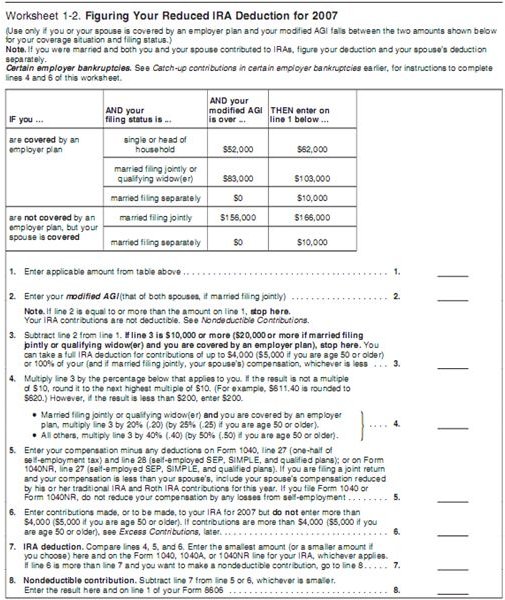Use the IRA Phaseout Worksheet 2011: How To Determine if IRA is Tax Deductable
The IRS IRA Rules
Before you can take the tax deduction for a Traditional IRA contribution you have to determine if you are eligible.
First, you must be eligible to make an IRA contribution at all. For that, you must have compensation in the year you contribute. You cannot contribute more than you earned in the tax year. So, if you had $2,000 in compensation, you can only contribute $2,000 to an IRA regardless of other limits.
The exception to this rule is the Spousal IRA Limit. If you are married filing jointly, the spouse can contribute based upon the joint compensation of the couple. In other words, if one spouse stays at home to raise the children, and the other spouse earns more than $10,000, then both of them can contribute $5,000.
Just because you can contribute to an IRA doesn’t mean it is deductible. Only contributions to a traditional IRA can be deductible. Contributions to a Roth IRA are not deductible.
IRA Contribution Deduction Income Limits
In order for an IRA contribution to be deductible one of two criteria must be met.
If neither you nor your spouse’s employer offers a retirement plan, then you can deduct the full amount of your traditional IRA contribution up to $5,000 for 2011. However, if you are over 50 then you can contribute an additional catch-up contribution of $1,000 for a total contribution of $6,000. Otherwise, you are subject to income limits.
Note the key phrase here is offer a retirement plan. It does not matter whether or not you participated. If the plan was offered (no matter how bad it might be) then this rule does not apply to you.
If either you or your spouse was covered by a retirement plan during any part of the tax year, then you must meet certain income limits to deduct your IRA contribution.
If you are married filing jointly, then you cannot take any IRA deduction on your 2011 taxes if your income (specifically your modified adjusted gross income, or MAGI) is over $110,000. If you are filing single (or head of household) then you cannot take any deduction if your income is over $66,000.
If you are married filing jointly and your income is less than $90,000 then you can take the full $5,000 IRA contribution deduction. (And the $1,000 catch-up contribution if you are over age 50.) If you are filing single, then you can take a full deduction if you make less than $56,000 for the tax year.
If only one spouse is covered by a retirement plan, then the non-covered spouse may take a full deduction if the joint income is less than $169,000 and no deduction if the income is higher than $179,000. Income levels in between result in a partial deduction.
IRA Contribution Income Phase-Out
If you earn between $90,000 and $110,000 as a married couple, or between $56,000 and $66,000 as an individual, you can take a reduced IRA contribution deduction. An online IRA contribution deduction calculator can determine how much of an IRA contribution deduction you can take on your taxes in 2011. If you would rather do the calculations by hand, there is an IRA income limit phase-out table that is used to determine how much you can deduct for making a traditional IRA contribution.
To determine how much of a deduction you can take, you will have to fill out Worksheet 1-2 of IRS Publication 590.
Reference: IRS Website - https://www.irs.gov/publications/p590/
